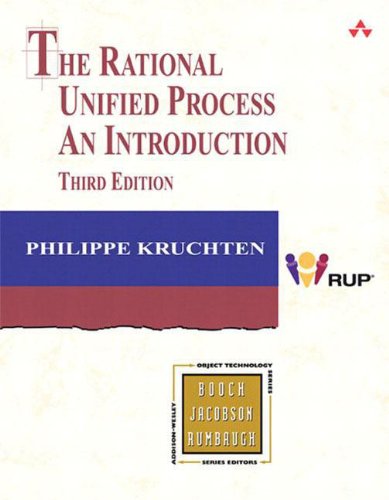

Most ebook files are in PDF format, so you can easily read them using various software such as Foxit Reader or directly on the Google Chrome browser.
Some ebook files are released by publishers in other formats such as .awz, .mobi, .epub, .fb2, etc. You may need to install specific software to read these formats on mobile/PC, such as Calibre.
Please read the tutorial at this link. https://ebooknice.com/page/post?id=faq
We offer FREE conversion to the popular formats you request; however, this may take some time. Therefore, right after payment, please email us, and we will try to provide the service as quickly as possible.
For some exceptional file formats or broken links (if any), please refrain from opening any disputes. Instead, email us first, and we will try to assist within a maximum of 6 hours.
EbookNice Team

Status:
Available0.0
0 reviews
ISBN 10: 0321197704
ISBN 13: 9780321197702
Author: Philippe Kruchten
I. THE PROCESS
Software Development Best Practices
The Value of Software
Symptoms and Root Causes of Software Development Problems
Software Best Practices
Develop Software Iteratively
Manage Requirements
Use Component-Based Architectures
Visually Model Software
Continuously Verify Software Quality
Control Changes to Software
The Rational Unified Process
What Is the Rational Unified Process?
The Rational Unified Process as a Product
Software Best Practices in the Rational Unified Process
Other Key Features of the Rational Unified Process
A Brief History of the Rational Unified Process
Static Structure: Process Description
A Model of the Rational Unified Process
Roles
Activities
Artifacts
Disciplines
Workflows
Additional Process Elements
A Process Framework
Dynamic Structure: Iterative Development
The Sequential Process
Overcoming Difficulties: Iterate!
Gaining Control: Phases and Milestones
A Shifting Focus across the Cycle
Phases Revisited
Benefits of an Iterative Approach
An Architecture-Centric Process
The Importance of Models
Architecture
The Importance of Architecture
A Definition of Architecture
Architecture Representation
An Architecture-Centric Process
The Purpose of Architecture
Component-Based Development
Other Architectural Concepts
A Use-Case-Driven Process
Definitions
Identifying Use Cases
Evolving Use Cases
Organizing Use Cases
Use Cases in the Process
II. PROCESS DISCIPLINES
The Project Management Discipline
Purpose
Planning an Iterative Project
The Concept of Risk
The Concept of Measurement
Roles and Artifacts
Workflow
Building an Iteration Plan
The Business Modeling Discipline
Purpose
Why Business Modeling?
Using Software Engineering Techniques for Business Modeling
Business Modeling Scenarios
Roles and Artifacts
Workflow
From the Business Models to the Systems
The Requirements Discipline
Purpose
What Is a Requirement?
Types of Requirements
Capturing and Managing Requirements
Requirements Workflow
Roles in Requirements
Artifacts Used in Requirements
Tool Support
The Analysis and Design Discipline
Purpose
Analysis versus Design
How Far Must Design Go?
Roles and Artifacts
Designing a User-Centered Interface
The Design Model
The Analysis Model
The Role of Interfaces
Artifacts for Real-Time Systems
Component-Based Design
Workflow
Tool Support
The Implementation Discipline
Purpose
Builds
Integration
Prototypes
Roles and Artifacts
Workflow
Tool Support
The Test Discipline
Purpose
Testing in the Iterative Lifecycle
Dimensions of Testing
Roles and Artifacts
Workflow
Tool Support
The Configuration and Change Management Discipline
Purpose
The CCM Cube
Roles and Artifacts
Workflow
Tool Support
The Environment Discipline
Purpose
Roles and Artifacts
Workflow
Tool Support
The Deployment Discipline
Purpose
Roles and Artifacts
Workflow
Typical Iteration Plans
Defining the Product Vision and the Business Case
Building an Architectural Prototype
Implementing the System
Implementing the Rational Unified Process
Introduction
The Effect of Implementing a Process
Implementing the Rational Unified Process Step by Step
Implementing a Process Is a Project
the rational unified process an introduction pdf
the rational unified process an introduction 3rd edition pdf
the rational unified process an introduction by philippe kruchten
the rational unified process an introduction de philippe kruchten
what is rational unified process
Tags: Philippe Kruchten, Rational, Introduction